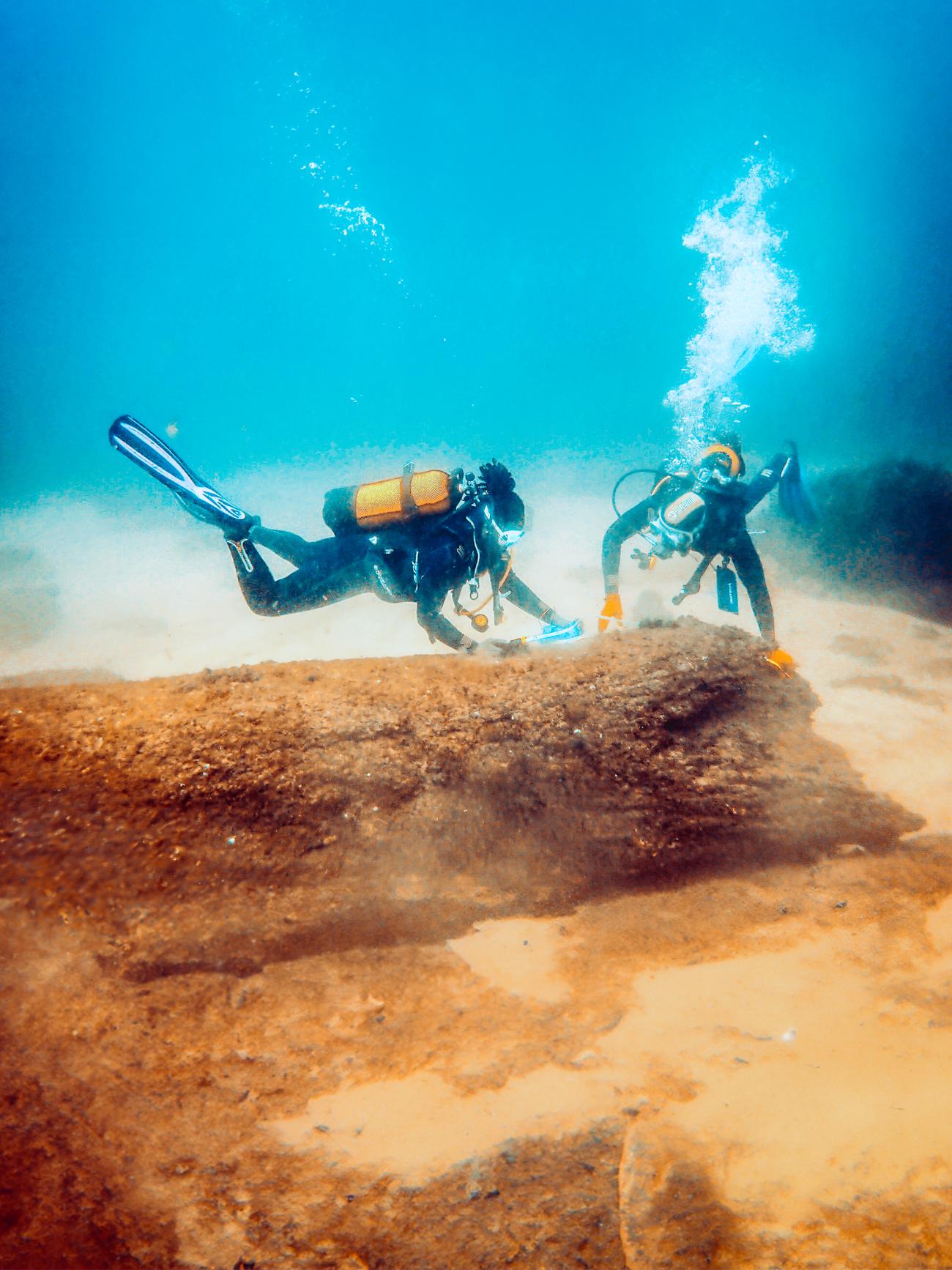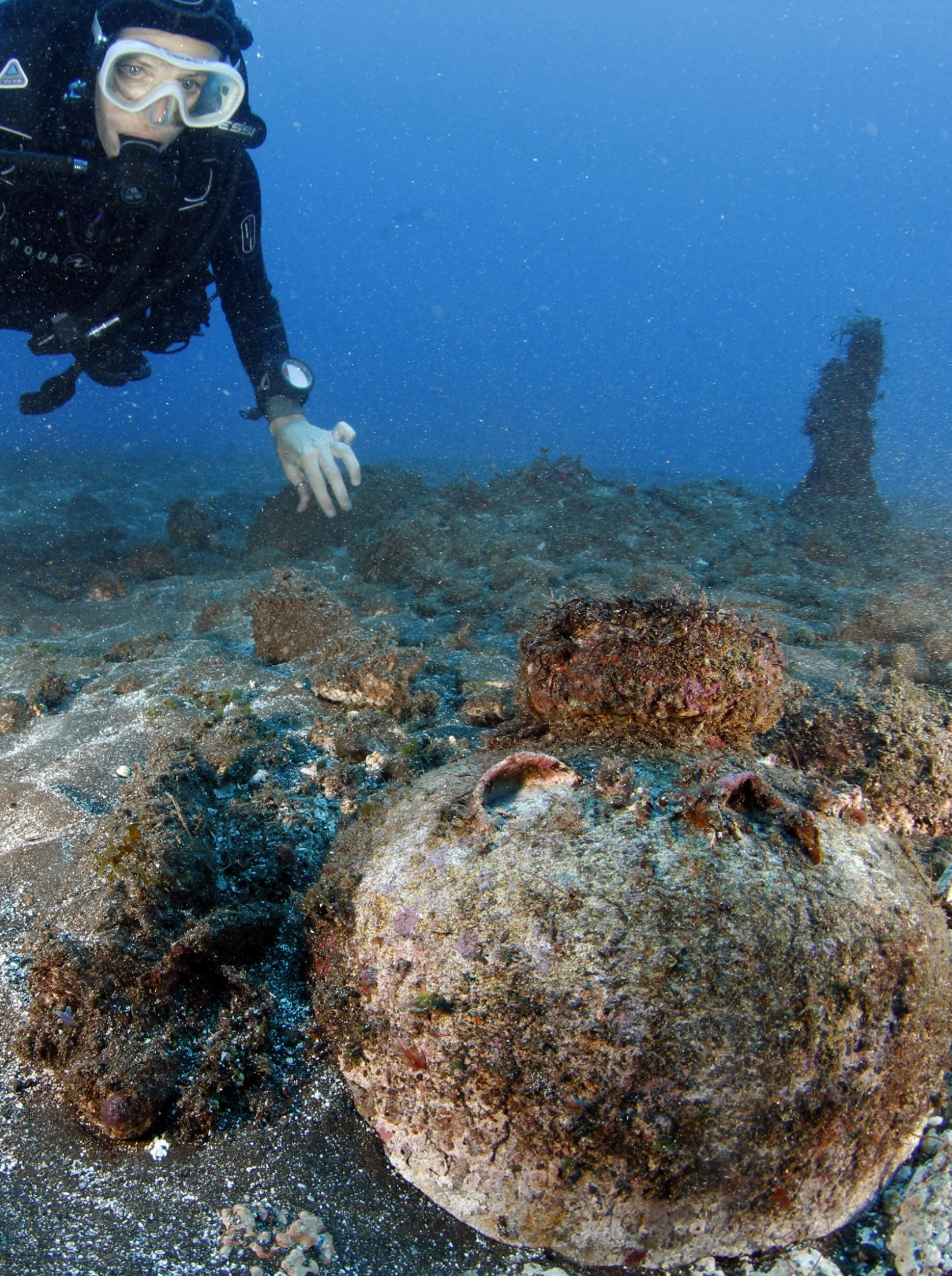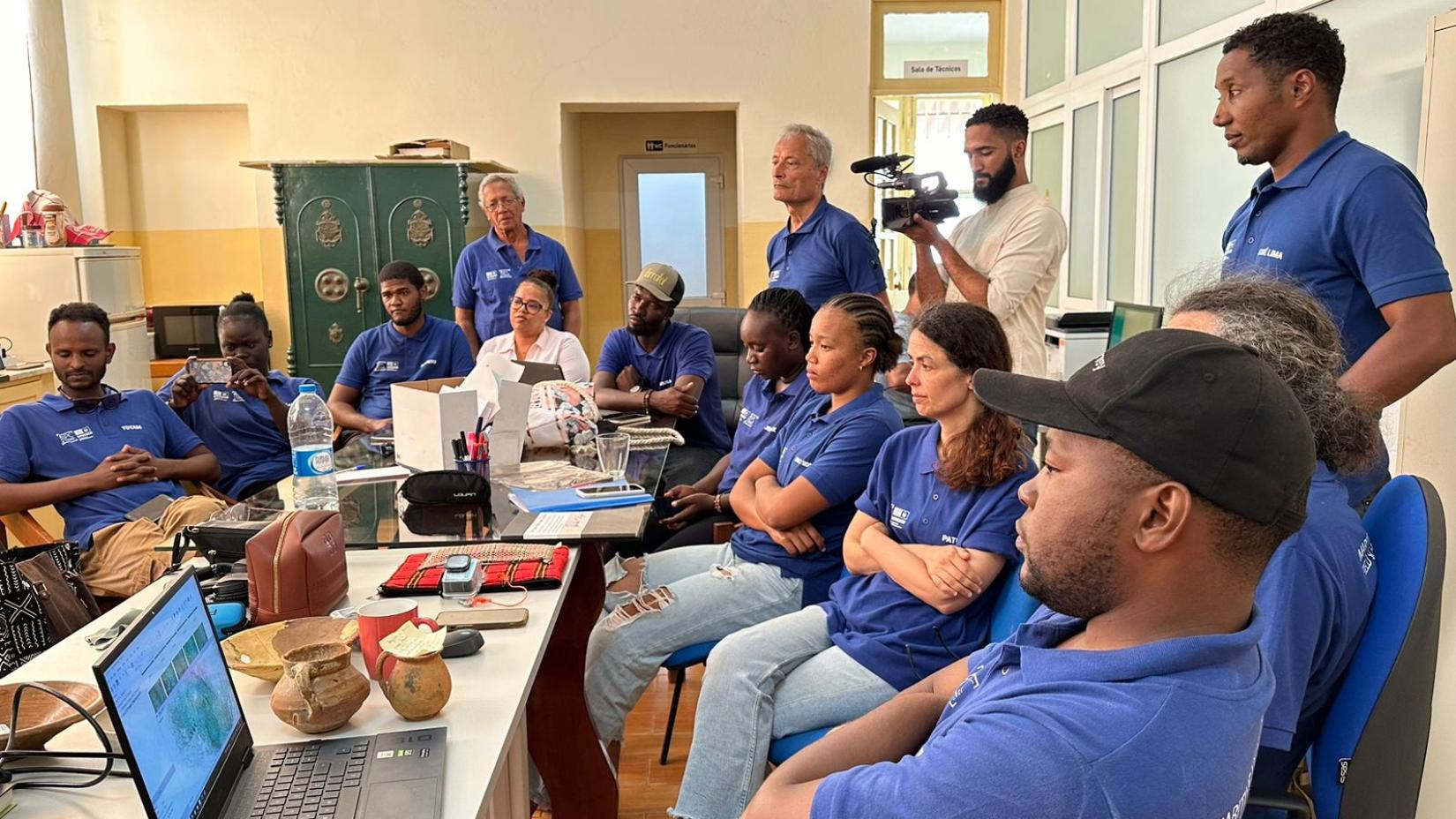À descoberta da História da Humanidade na África através do mar que nos une

Cidade Velha – Cabo Verde sedia o primeiro Campo Escola de Arqueologia Subaquática
A Convenção sobre a Proteção do Património Cultural Subaquático foi adotada em 2001 na sessão plenária da 31ªConferência Geral da UNESCO para combater a pilhagem, a exploração comercial, o tráfico ilícito ou o tratamento inadequado do património cultural subaquático. A Convenção promove a proteção jurídica dos sítios de património cultural subaquático e dos bens culturais. Responde igualmente à necessidade mundial de uma orientação científica e facilita ainda a cooperação bilateral e multilateral.
PT
Scroll down for EN version

A riqueza do património cultural subaquático do continente africano está a tornar-se cada vez mais evidente. As investigações arqueológicas subaquáticas em curso têm revelado uma parte da história e da cultura marítimas marcada, em particular, pela engenhosidade africana na tecnologia náutica, pelo papel da região no comércio internacional milenar e ainda pelas culturas marítimas das comunidades costeiras e insulares.
Nos últimos anos, foram feitos progressos significativos em África, principalmente na formação de capital humano capaz de documentar e proteger o património cultural subaquático da região. Além dessas iniciativas, vários encontros nacionais e regionais foram organizados pela UNESCO e pelos seus escritórios locais para promover a ratificação e a implementação da Convenção de 2001. Até à data, 15 países africanos ratificaram este instrumento de normalização da UNESCO para a proteção dos bens culturais submersos. Muitas leis nacionais estão a ser revistas para reforçar a proteção, enquanto o número de profissionais que se dedica à arqueologia subaquática está a aumentar graças ao reforço das capacidades e programas académicos da UNESCO, como foi o caso durante a recente formação organizada em janeiro de 2024 no centro CAIRIM em Moçambique.
É, pois, na senda das iniciativas de formação que decorre de 1 a 15 de junho de 2024 em Cabo Verde o curso de verão Santiago 24, uma formação prática em contexto de investigação que visa promover a preparação especializada em arqueologia subaquática para arqueólogos e técnicos do património que trabalham na região.
Esta iniciativa é liderada pelo Escritório Regional da UNESCO para a África Ocidental em Dakar em parceria com o Instituto do Património Cultural (IPC) do Ministério da Cultura e Indústrias Criativas de Cabo Verde, a Cátedra UNESCO "O Património Cultural do Oceanos", sediada na Universidade Nova de Lisboa (Portugal), e o clube de mergulho Santiago Dive Center, no Tarrafal (Cabo Verde).
Trata-se igualmente de dar continuidade à investigação realizada em Cabo Verde, sob a direção da Cátedra UNESCO em Lisboa, do projeto Concha e do projeto MARGULLAR. Essa investigação, que se concentrou no ancoradouro da Ribeira Grande de Santiago (Cidade Velha, Património Mundial) e em vários naufrágios na mesma ilha, permitiu, pela primeira vez, documentar sítios arqueológicos subaquáticos do arquipélago de Cabo Verde com uma abordagem científica segundo os cânones da UNESCO.
O curso de verão - Santiago 24 inclui atividades de campo no ancoradouro na Cidade Velha e no sítio de naufrágio do navio Urânia. O ancoradouro da Cidade Velha preserva importantes depósitos de superfície, entre 15 e 30 m de profundidade, depositados durante as atividades portuárias ali realizadas principalmente entre os séculos XV e XVII, incluindo um grande número de cerâmicas e âncoras. O naufrágio do Urânia, a uma profundidade de 5 a 8 m, preserva restos de uma fragata portuguesa que ali naufragou em 1809, um vasto tumulus com lastro de ferro e canhões.
Além do trabalho subaquático, o curso permite realizar estudos das coleções em reserva no Museu de Arqueologia da Praia, de forma a completar a interpretação dos vestígios encontrados nos dois sítios suprarreferidos. A atividade no museu reforça assim a capacidade dos participantes nos domínios da gestão de coleções e museologia.
Porquê o arquipélago de Cabo Verde?
A escolha de Cabo Verde para organizar a formação em arqueologia subaquática Santiago 24 não é por acaso.
Situado entre Europa, África e América, conhecido enquanto ponto de cruzamento intercontinental do Atlântico para o tráfego marítimo, o arquipélago de Cabo Verde contém mais de cinco séculos de vida marítima no seu fundo marinho. O seu património cultural subaquático, que no passado foi vítima de exploração comercial, reflete a história do Atlântico, sendo ainda um testemunho importante para compreender os mecanismos da aventura fundadora do mundo moderno.
A Cidade Velha, centro histórico da Ribeira Grande, inscrita na Lista do Património Mundial em 2009, acolhe, por isso, parte das atividades do curso de verão, sendo um importante laboratório para estudar a complementaridade entre a Convenção para a Protecção do Património Cultural Subaquático, de 2001, e a Convenção para a Protecção do Património Mundial Cultural e Natural, de 1972.
Esta cidade atlântica, fundada no final do século XV, foi uma excepcional encruzilhada do comércio marítimo internacional, entre as rotas da África e do Cabo, Brasil e Caribe. Forneceu uma imagem inicial de visões geopolíticas transcontinentais. A sua localização isolada na ilha, mas perto da costa africana, tornou-a uma plataforma essencial para o tráfico atlântico de escravos. Assim, o curso contribui para documentar os testemunhos materiais deste Património Mundial e, por outro lado, fortalecerá o conhecimento sobre os valores memoriais e o Valor Universal Excepcional deste sítio, demonstrando as possibilidades de sinergia entre as Convenções da UNESCO de 1972 e 2001.
Sobre o Campo Escola de Arqueologia Subaquática - o primeiro jamais realizado

Este curso permite aos jovens investigadores de África aprofundar os conhecimentos já adquiridos nas áreas da arqueologia subaquática e da gestão do património cultural subaquático num ambiente de investigação. Participaram técnicos de património, arqueólogos e estudantes de arqueologia. No total foram 10 participantes, jovens vinculados a várias instituições públicas de Cabo Verde, Comores, Moçambique, Eritreia, Gâmbia e Senegal, que durante 10 dias estiveram a explorar a história por debaixo das águas.
Na generalidade, o programa do campo conta com os seguintes tópicos:
- Prospeção subaquática e escavações arqueológicas
- Estudo de achados arqueológicos
- Documentação 3D do Patrimônio
Comtempla duas fases, estando previstos mergulhos na Cidade Velha, no antigo ancoradouro, e na cidade da Praia, no local do naufrágio do Urânia.
Trabalho de campo
O trabalho de campo tem vários componentes. Inicialmente, treinamento on-the-job que visa melhorar as habilidades de mergulho dos participantes. Os participantes participarão nas diversas atividades de prospecção, utilizando metodologias não intrusivas, incluindo mergulho livre utilizando GPS, radial, azimutes e transectos pré-definidos, acompanhados de documentação e posicionamento de artefactos, fotogrametria 3D, registo e estudos de âncoras e canhões.
As atividades de mergulho serão planeadas diariamente na reunião preparatória no início de cada dia, durante a qual serão discutidos os objetivos a serem alcançados, os princípios teóricos a serem implementados e as tarefas a serem realizadas. Estas tarefas serão realizadas no ancoradouro da Cidade Velha e/ou no local do naufrágio do Urânia, na Praia.
Museologia e gestão de coleções
No Museu de Arqueologia da Praia, são realizados trabalhos de inventariação de achados e aplicados métodos de documentação do património em 3D e outros. Os participantes trabalham com coleções do museu.
A relação com os Objetivos de Desenvolvimento Sustentável
Esta atividade contribui para o alcance dos ODS 4.7, 11.4, 12b, 14.5 e 14.7. As ligações com a Agenda 2030 para o Desenvolvimento Sustentável, em particular no que diz respeito à educação, proteção e compreensão do património e ao seu contributo para a coesão social, melhores oportunidades económicas, turismo sustentável que cria emprego e promove produtos culturais locais e promove a resiliência da comunidade, serão destacadas ao longo desta atividade.
O curso é uma grande contribuição para a Década das Nações Unidas da Ciência Oceânica para o Desenvolvimento Sustentável (2021-2030) e para a Agenda 2063 da União Africana, em particular da sua aspiração 5 - "Uma África com uma forte identidade cultural, um património comum, valores e ética". Além disso, a atividade, que decorre na Cidade Velha, local de memória ligado à escravatura, é uma forma de assinalar os 30 anos da Rota do Escravo.
EN version
Discovering the History of Humanity in Africa through the sea that unites us
The Convention on the Protection of the Underwater Cultural Heritage was adopted in 2001 at the plenary session of the 31st UNESCO General Conference to combat looting, commercial exploitation, illicit trafficking, or inadequate treatment of underwater cultural heritage. The Convention promotes the legal protection of underwater cultural heritage sites and cultural goods. It also responds to the global need for scientific guidance and facilitates bilateral and multilateral cooperation.

The richness of the underwater cultural heritage of the African continent is becoming increasingly evident. Ongoing underwater archaeological investigations have revealed part of the maritime history and culture marked particularly by African ingenuity in nautical technology, the region's role in millennial international trade, and the maritime cultures of coastal and island communities.
In recent years, significant progress has been made in Africa, mainly in training human capital capable of documenting and protecting the region's underwater cultural heritage. Besides these initiatives, several national and regional meetings have been organized by UNESCO and its local offices to promote the ratification and implementation of the 2001 Convention. To date, 15 African countries have ratified this UNESCO standard-setting instrument for the protection of submerged cultural goods. Many national laws are being reviewed to strengthen protection, while the number of professionals dedicated to underwater archaeology is increasing thanks to UNESCO's capacity-building and academic programs, as was the case during the recent training organized in January 2024 at the CAIRIM center in Mozambique.
It is in the context of these training initiatives that the summer course Santiago 24, a practical training in a research context, takes place from June 1 to 15, 2024, in Cape Verde, aimed at promoting specialized preparation in underwater archaeology for archaeologists and heritage technicians working in the region.
This initiative is led by UNESCO's Regional Office for West Africa in Dakar in partnership with the Cultural Heritage Institute (IPC) of the Ministry of Culture and Creative Industries of Cape Verde, the UNESCO Chair "The Cultural Heritage of the Oceans," based at the Nova University of Lisbon (Portugal), and the diving club Santiago Dive Center, in Tarrafal (Cape Verde).
It is also a continuation of the research carried out in Cape Verde, under the direction of the UNESCO Chair in Lisbon, the Concha project, and the MARGULLAR project. This research, which focused on the anchorage of Ribeira Grande de Santiago (Cidade Velha, World Heritage) and several shipwrecks on the same island, allowed, for the first time, to document underwater archaeological sites of the Cape Verde archipelago with a scientific approach according to UNESCO standards.
The summer course - Santiago 24 includes field activities at the anchorage in Cidade Velha and the shipwreck site of the Urânia ship. The anchorage of Cidade Velha preserves important surface deposits, between 15 and 30 meters deep, deposited during port activities mainly between the 15th and 17th centuries, including a large number of ceramics and anchors. The wreck of the Urânia, at a depth of 5 to 8 meters, preserves remains of a Portuguese frigate that sank there in 1809, a vast tumulus with iron ballast and cannons.
In addition to underwater work, the course allows for studies of collections in reserve at the Archaeology Museum of Praia, to complete the interpretation of the remains found at the two aforementioned sites. The museum activity thus strengthens the participants' capacity in the fields of collections management and museology.
Why the archipelago of Cape Verde?
The choice of Cape Verde to organize the Santiago 24 underwater archaeology training is no accident.
Located between Europe, Africa, and America, known as an intercontinental crossing point of the Atlantic for maritime traffic, the Cape Verde archipelago contains more than five centuries of maritime life in its seabed. Its underwater cultural heritage, which in the past was a victim of commercial exploitation, reflects the history of the Atlantic, being an important testimony to understand the mechanisms of the founding adventure of the modern world.
Cidade Velha, the historic center of Ribeira Grande, inscribed on the World Heritage List in 2009, therefore hosts part of the summer course activities, being an important laboratory to study the complementarity between the 2001 Convention for the Protection of the Underwater Cultural Heritage and the 1972 Convention for the Protection of the World Cultural and Natural Heritage.
This Atlantic city, founded at the end of the 15th century, was an exceptional crossroads of international maritime trade, between the routes of Africa and the Cape, Brazil, and the Caribbean. It provided an initial image of transcontinental geopolitical visions. Its isolated location on the island, but close to the African coast, made it an essential platform for the Atlantic slave trade. Thus, the course contributes to documenting the material testimonies of this World Heritage and, on the other hand, will strengthen knowledge about the memorial values and the Outstanding Universal Value of this site, demonstrating the possibilities of synergy between the UNESCO Conventions of 1972 and 2001.

About the Underwater Archaeology Field School - the first ever conducted
This course allows young researchers from Africa to deepen the knowledge already acquired in the areas of underwater archaeology and underwater cultural heritage management in a research environment. Heritage technicians, archaeologists, and archaeology students participated. In total, there were 10 participants, young people linked to various public institutions in Cape Verde, Comoros, Mozambique, Eritrea, Gambia, and Senegal, who for 10 days explored the history beneath the waters.
In general, the field school's program includes the following topics:
- Underwater prospection and archaeological excavations
- Study of archaeological findings
- 3D Documentation of Heritage
It includes two phases, with dives planned in Cidade Velha, at the old anchorage, and in Praia, at the site of the Urânia shipwreck.
Fieldwork
Fieldwork has several components. Initially, on-the-job training aims to improve the participants' diving skills. The participants will take part in various prospection activities, using non-intrusive methodologies, including free diving using GPS, radial, azimuths, and predefined transects, accompanied by documentation and positioning of artifacts, 3D photogrammetry, recording, and studies of anchors and cannons.
Diving activities will be planned daily at the preparatory meeting at the beginning of each day, during which the objectives to be achieved, the theoretical principles to be implemented, and the tasks to be performed will be discussed. These tasks will be carried out at the anchorage in Cidade Velha and/or at the site of the Urânia shipwreck, in Praia.
Museology and collections management
At the Archaeology Museum of Praia, inventorying of finds is carried out and 3D heritage documentation methods are applied, among others. Participants work with the museum's collections.
The relationship with the Sustainable Development Goals
This activity contributes to the achievement of SDGs 4.7, 11.4, 12b, 14.5, and 14.7. The connections with the 2030 Agenda for Sustainable Development, particularly with regard to education, protection, and understanding of heritage and its contribution to social cohesion, better economic opportunities, sustainable tourism that creates jobs and promotes local cultural products, and promotes community resilience, will be highlighted throughout this activity.
The course is a major contribution to the United Nations Decade of Ocean Science for Sustainable Development (2021-2030) and the African Union's Agenda 2063, particularly its aspiration 5 - "An Africa with a strong cultural identity, common heritage, values and ethics." In addition, the activity, which takes place in Cidade Velha, a place of memory linked to slavery, is a way of marking the 30th anniversary of the Slave Route.
Nota:
Texto Original UNESCO Dakar.
Original text UNESCO Dakar (with free translation)



